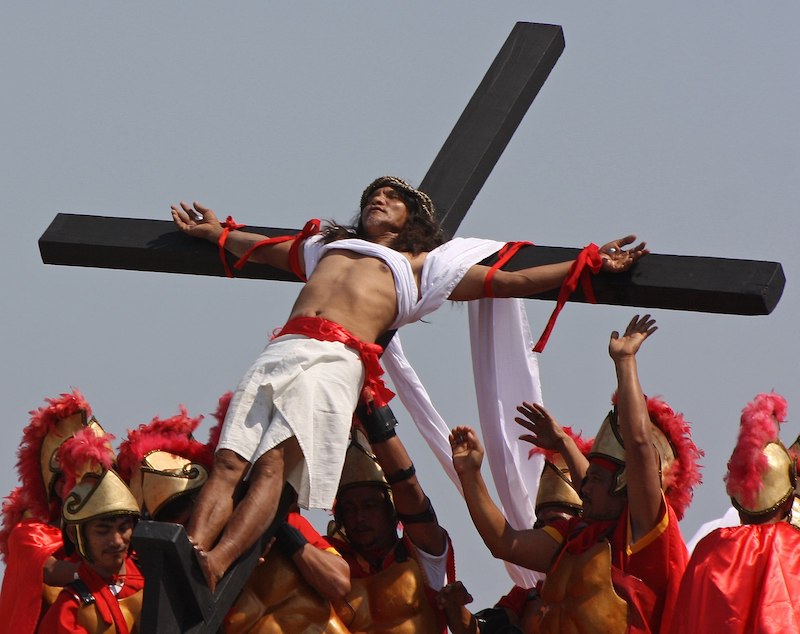This year I thought I would reflect on Good Friday since I have reflected on Holy Saturday for at least eight years, if not more. Everyone knows that it was the day when Pontius Pilate condemned Jesus to death. Following that condemnation, Jesus was scourged, forced to wear a crown of thorns, then carry his wooden cross through the streets to the site of his execution. Since medieval times, people have followed the path from the former Antonia Fortress to the Church of the Holy Sepulcre. The church considers it a particularly religious practice when done on Good Friday in Jerusalem. Many churches have images called “Stations of the Cross,” which commemorate the events from the condemnation to his internment in place of the physical journey. The stations are frequently done weekly throughout the year but have special significance during Holy Week, especially Good Friday.
Flagellation is a frequent practice among two vastly different groups of practitioners. One group represents those who enjoy pain, often in a sexual context. The second group is composed of some monastics and members of rigorous religious organizations where repentance is heavily emphasized. Flagellants scourge themselves with whips, sticks, thorn branches, rope strings with bits of metal on the ends, and canes. Public flagellation is, in some countries, used as a punishment for legal or moral infractions. The chastisement can range in severity and the number of lashes, depending on the crime. A penalty of 100 lashes is often fatal.
The Philippines is predominantly Roman Catholic and has many places known for their intense dedication to their faith. In Pampanga province, north of Manila on the island of Luzon, they have been celebrating representations of the stations of the cross, including rows of flagellants walking for miles while scourging themselves until their backs are raw and their blood flowing.
Another Good Friday practice performed in Pampanga is that of actual crucifixion. Men and women who have chosen to do this are frequently repenting of sins but also may do it to share in the passion of Christ or even to thank God for particular events such as loved ones recovering from near-fatal illnesses or accidents. For some, it may be a rather painful way to be like the Pharisee in the temple, raising his religious status by showing himself to be pious. Still, I am sure that the vast majority of those who do participate do it for the glory of God and to show their love and reverence. They want to imitate Jesus as much as possible, and this is one way to do that.
Some participants choose to don a white loincloth and then be tied to the crossbars of the crosses they have carried for some distance before being raised upright. Others lie on the cross in the traditional position, have their arms tied to the cross member in several places, then have four-inch nails driven through their hands and five-inch spikes through their feet. They remain upright on the cross for as little as five minutes or as much as an hour, depending on how much pain they can bear. Spectators worldwide come to see the spectacle enacted every Good Friday except for the past two years due to the pandemic. I expect there are other places in the world where reenactments like these take place, but Pampanga is one of the best known and most publicized.
Jesus, as we traditionally see his crucifixion portrayed, wasn’t always shown with bindings and footrests to help support his weight. The bent knees we see on crucifixes, and the downward slump of the corpus had the purpose of illustrating a posture of slow suffocation since the ribs could not inflate fully. The corpus also shows the incision of the spear point and even the trickles of blood from the crown of thorns. What crucifixes often can’t show is the sun beating down mercilessly, sweat trickling into the raw gashes of the scourge marks, the slow dehydration that can cause delusions, and eventual death.
Jesus, as the gospels tell us, spent six hours in this torment, not to mention the previous torture of the scourging, carrying the cross until he could bear it no longer, and the strength-stealing suffering of a sleepless night and the prospect of more torment to come.
I do not imagine Jesus went through all that he did because he wanted to. It seems more of an act of submission, much as the actions of the penitents today. Many Christians put crosses on their front lawns, hang rosaries from their rear-view mirrors, wear necklaces showing crosses, crucifixes, and other iconic symbols. It is showing their religious affiliation but also as an act demonstrating their faith. The liturgies and prayers we attend or participate in during Holy Week are symbols of what our faith is about and reminders of who and what Jesus was besides being a charismatic preacher, teacher, rabbi, and human being during his earthly lifetime.
May we take the time on this Holy Saturday to reflect deeply on what Holy Week represents, especially Good Friday. In what other ways can we show our submission to Christ, emulate his life, illustrate his teachings, and devotion to God? There is more to Holy Saturday than dyeing eggs, stuffing baskets with candy and chocolates, and new clothes. There’s more than starting preparations for a large dinner (or a smaller one if the family can’t travel to visit). There is more to faith than twice-a-year attendance at the major celebrations of the church.
How can you demonstrate your faith?
Have a blessed Easter.
Image: Lifted (2011), by istolethetv. Found at Wikimedia Commons
Linda Ryan is a co-mentor for an Education for Ministry group, an avid reader, Baroque and Renaissance music lover, and retired. She keeps the blog Jericho’s Daughter. She lives with her three cats near Phoenix, Arizona.

